Abstract
The limited availability of fossil fuel and the growing energy demand in the world creates global energy challenges. These challenges have driven the electric power system to adopt the renewable source-based power production system to get green and clean energy. However, the trend of the introduction of renewable power sources increases the uncertainty in the production, control, and operation of power systems due to the erratic nature of the environment. To overcome these meteorological conditions, some support systems, such as storage devices, are integrated with renewable energy sources (RES). A number of storage devices are hybridized to get the hybrid energy storage system (HESS) to get a potential solution for these microgrid problems. For maintaining the robustness and reliability of the power system, proper control, and management of power in the microgrid is very important. In this paper, an analytical study related to power management strategies is given along with different interconnection topologies for the HESS. Analysis and control of storage devices are necessary to avoid the premature degradation of the devices and to get their optimal utilization. Therefore, this article attempts to include different power management schemes used in AC/DC microgrids. Furthermore, various control techniques specific to different energy storage devices are reviewed extensively, which would serve as a complete guide for the design and implementation of a hybrid AC/DC microgrid.
1. Introduction
The depletion of fossil fuel and their impact on the environment has resulted in the transition toward renewable energy sources (RES) to overcome the global energy challenges. These RESs are great alternatives to power generation to reduce CO2 and greenhouse gas emissions [1]. Some of the most prominent RESs are solar photovoltaic (PV), hydro, wind, geothermal, biomass, etc. Due to the low operating cost, easy installation process, and low maintenance, the PV system becomes the most promising technology to cover future energy demands [2]. In recent years, environmental sustainability, efficiency, reliability, robustness, power management, and some power quality features are some of the benefits that are provided by microgrid (MG) technology [3]. A microgrid is basically a controllable power supply system that interconnects with a group of distributed energy resources (DERs) and loads in a defined electrical boundary. It can operate either in islanded/isolated mode or in grid-connected mode [4]. The simple layout of a microgrid with different energy storage devices and utility grids is shown in Figure 1.
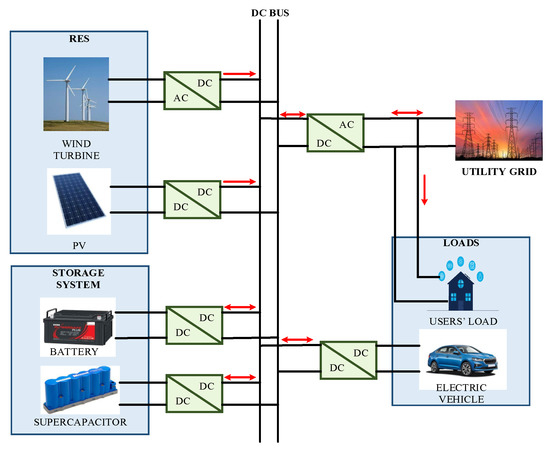
Figure 1.
Outline of a microgrid.
The microgrid can be considered as a small-scale low power supply system, but there are a number of factors that differentiate the microgrid from the existing conventional grids. An analytical comparison is presented in Table 1 between the conventional grid and microgrid.

Table 1.
Operational Difference between Microgrid and Existing Conventional Grid.
The intermittent nature of the environment poses new challenges with the use of RESs. The issues with meteorological conditions are the variations in power generation [8]. As a consequence, the power balance between generation and loads, constant power supply to the loads, microgrid stability, and reliability become promising problems in MG operation. To overcome these problems, storage devices are integrated with the microgrid nowadays. Integration of microgrids with storage devices can overcome power fluctuations, regulate the frequency, improve power qualities, and enable some ancillary services [9]. A combination of different energy storage devices with complementary characteristics is taken into consideration to form a hybrid energy storage system (HESS) to overcome the limitations of a single storage system. In most MG applications, the battery storage is integrated with the supercapacitor (SC) storage system to form the composite storage system [10]. The life span of the HESS is a major concern to evade the premature degradation of the devices. Hence, in a HESS, the battery will supply the average power demand of the system and the transient/sudden power requirement of the MG will be supplied by the SC to avoid the deterioration of their life cycle [11].
The combined operation of these RESs, loads, and storage devices in the MG requires a proper control strategy to get the optimal use of the distributed generators (DGs) to feed the connected loads. Hence, a suitable power management strategy is very important for the MG operation [12]. A low-pass filter-based power management study was presented in [10,13,14] to share the total system power requirement between the battery and SC storage system in a PV-integrated hybrid AC/DC microgrid system. In this literature, conventional proportional-integral (PI) controllers are utilized to maintain a simple control structure. A sliding mode controller-based power management control scheme was proposed in [15] for a PV, wind, and fuel cell with HESS microgrid along with linear and nonlinear loads. In [16], a fixed frequency-based PWM, and in [17], an adjustable bandwidth-based control structure is implemented by using the sliding mode controller to overcome the issues with high and variable frequency-based operation using conventional PI controllers. A battery energy storage-based microgrid was controlled by using the combination of the fuzzy logic controller (FLC) and the DC bus voltage regulation technique in [18]. Here, the state of charge (SOC) and charging/discharging of the battery were properly monitored by the FLC compared to the conventional droop control techniques. A frequency signaling-based fuzzy logic control is utilized in [19] for an islanded AC microgrid with battery energy storage system. For efficient utilization of battery and SC, a multimode fuzzy logic-based power allocation method was proposed in [20]. Nowadays, these power management techniques play very important roles in designing of electric vehicle charging stations [21]. A number of filtering-based techniques, such as the use of rate limiters, high pass filters, low pass filters, and ramp rates, are explained in various works of literature for the management and control of power disparity between generation and demand. In addition, some intelligent control techniques, such as fuzzy logic control, neural network-based controls, and model predictive control (MPC), are used for power management in the MG nowadays.
Different pieces of literature have investigated related to microgrid operations. In various papers, either they focused on different storage devices used in MG or different power management techniques used in microgrid applications. However, in this review article, the analysis is done for different storage devices along with various power management techniques. The main discussion points of this paper are listed below.
- (1)
- Requirement for integration of renewable energy-based microgrid with the existing conventional grids and the operational difference between the microgrid and conventional grid;
- (2)
- Necessity of storage devices in the MG applications and hybridization of two devices by considering different characteristics to get the optimal benefits;
- (3)
- Three types of interconnection topologies, i.e., passive connection, semi-active connection, and active connection of HESS are discussed to increase the system efficiency and reduce the cost;
- (4)
- Comparison of several classical and intelligent approaches for power management in the microgrid with their advantages and limitations are explained;
- (5)
- Finally, various recent trends in power management strategies are compared in AC/DC microgrids.
The next parts of the paper are organized as: Section 2 explains several characteristics of storage devices and their interconnection topologies with the microgrid. Different power management schemes for the hybrid AC/DC microgrid are analyzed in Section 3. In Section 4, a comparison of power management schemes in AC/DC microgrid is presented. Finally, Section 5 gives the concluding remarks of this review article.
2. Storage Devices and Its Requirement in Microgrids
The adoption of renewable energy sources to reduce greenhouse gas emissions and meet the growing energy demand presents new challenges. Due to the weather-dependent nature of renewable sources, they are not able to generate constant power throughout the day. This is because of the meteorological conditions, such as unavailability of constant solar irradiance or wind etc. Additionally, environmental temperature, latitude, and longitude of the place affect power generations. This situation may create an unbalance power flow among the loads and generation, which in terms reduces the stability and reliability of the microgrid operations. Hence, the design, control, and performance of the microgrid are still very challenging due to the intermittent nature of renewable sources, uncertain load profiles, and the low inertia introduced by the interfacing converters [22]. Nowadays, storage devices give a promising solution to some the operational issues, such as power quality, stability, controllability, and reliability of MG integrated with RES. Hence, it is important to integrate the storage devices with microgrid technologies to improve the flexibility in the performance. Furthermore, the integration ensures to store the excess power generated from the renewable sources for later use. The integration of the storage system also enhances the efficiency by doing power balance in the MG and by reducing the losses in the system. So, this section introduces various energy storage system and their different topologies to improve the power quality, reliability, resiliency, and power management within the microgrid.
2.1. HESS Technology
An ideal application of a storage system mainly requires both high energy density and high power density. Yet, due to its own limitations, a solo storage device cannot provide both high power and high energy density. Hence, it is necessary to integrate two or more storage devices to get a composite energy storage system. In [23], it is investigated the application of HESS in RES-integrated microgrid systems. Different types of modeling and power management schemes for HSS in microgrid applications are presented in [24]. A dynamic power control scheme for PV and fuel cell integrated battery and supercapacitor system is proposed in [25]. The positive influences of HESS on microgrid power generations, such as power balance, stability, and power quality improvements, are studied in [26]. Load management and dynamic control of storage devices in a remote housing application are proposed in [27]. A stand-alone hybrid microgrid is taken for the control study in [27]. Table 2 gives the summary of different storage devices along with their characteristics.

Table 2.
Characteristics of Different Storage Devices [28,29].
Some of the ideal technical characteristics, such as energy and power density, life span, efficiency, response time, and cost of different commonly used storage devices, are compared in Table 2. Hybridization of devices is done by considering the area of applications. In microgrid application, it is necessary to combine a high power density device with a high energy density-based device so that it can handle both steady and transient operations in the system. The high energy density-based battery storage system can supply average power to the system for a longer duration. Any sudden changes in the system can cause fast discharging/charging of the battery, which may affect the battery life. Hence, a high power density device, i.e., supercapacitor is chosen to combine with a battery [30]. The SC can handle sudden surges in the system as its response time is very less and fast charging/discharging cycle compared to the battery. So for microgrid application, battery and SC are combined to construct a hybrid energy storage system. The technical issues related to MG operations with RES integration, such as DC bus voltage regulation, constant power supply to a load, power quality improvement, frequency stability, etc. can be solved by the HESS [26].
2.2. HESS Interconnection Topologies
The efficiency, life span, charging/discharging, flexibility, dynamic performance, etc. of the storage system mainly depends on the interconnection topologies. The HESS can be connected to the DC bus or AC bus directly without using any power converters or through the power converters. As most of the storage devices supply DC voltage, hence coupling of the storage with a DC bus minimizes the complexity, improves efficiency, and reduces the cost compared to AC bus coupling [31]. The function of the power management scheme and system requirement mainly decide the connection topologies of the HESS. Generally, HESS connections can be classified on the basis of passive, semi-active, and active connections of power converters. These three types of interconnection topologies are analyzed in Table 3.

Table 3.
Comparison of Different HESS Interconnection Topologies.
2.2.1. Passive Connection
The simplest and cheapest connection of HESS with the MG is the passive type of connection [32,33]. A typical passive connection is shown in Figure 2. In this connection, the storage devices are directly connected to the DC bus without any power converters. So, for this type of connection, terminal voltage level matching of HESS with the DC bus or with the connected load should be the prime concern [36]. The system power requirement will be shared by the battery and supercapacitor according to their respective internal impedances [37]. For any sudden variation in the system, the momentary power is compensated by the supercapacitor due to its low internal impedance. However, the optimal utilization of HESS is not possible without controlled power converters. Again, the variation of the terminal voltage of the battery is very slow compared to the supercapacitor, hence it is very challenging to maintain the SOC of storage devices and the DC bus voltage [38]. This type of topology is not normally adopted in MG applications due to the following limitations.
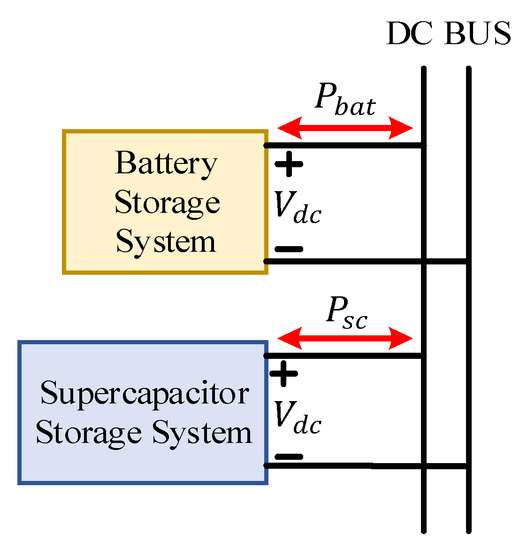
Figure 2.
Passive connection of HESS.
- The terminal voltage of HESS should be exactly matched with the connected load and DC link voltage;
- A lack of control flexibility and the sharing of power mainly depends on the internal impedance;
- As HESS is directly connected to the bus, there are more chances of cascaded failure during any fault in the system.
2.2.2. Semi-Active Connection
The semi-active type connection is the extended form of passive topology. In this type of connection, one ESS is connected directly to the DC bus and another ESS is connected to the bus through a DC/DC bidirectional converter. The operational flexibility and controllability of semi-active type connections are better compared to passive connections.
Figure 3a presents a battery semi-active topology where the battery is coupled to the bus through a converter and SC is directly connected to the bus [39]. In this connection, the battery charging/discharging current can be controlled up to some extent irrespective of any transients in the power demand. Here, it is not necessary to match the DC bus voltage with the battery terminal voltage. Yet, the uncontrolled supercapacitor terminal voltage causes fluctuations in bus voltage that may lead to system instability and poor power quality. So, to maintain a comparatively steady and stable voltage at the DC bus, an extremely large capacity of SC is required, which is not cost-effective.
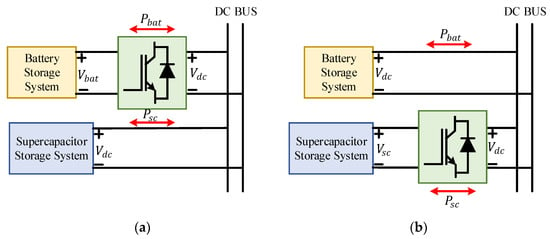
Figure 3.
(a) Battery semi-active topology, (b) SC semi-active topology.
Similarly, Figure 3b shows a supercapacitor semi-active topology, where the battery is directly coupled with the DC bus and the SC is connected through a DC/DC bidirectional converter [40]. Here, the SC can operate for a wider range of voltage and this can improve the efficiency of the SC. Although the battery takes care of stable bus voltage, any sudden fluctuating high current in the system due to fault can affect the battery life in a negative manner. Even if this type of connection provides better flexibility compared to passive connections, still it is not used in microgrid applications due to the following limitations.
- When SC is directly linked to the DC bus, the bus voltage fluctuates in any contingencies in the system;
- When SC is coupled to the bus through the DC/DC converter, the converter should be designed properly to tackle the high-power surges of the system.
2.2.3. Active Connection
In the case of active interconnection topology, both battery and supercapacitor are connected to the DC bus through separate DC/DC bidirectional converters [30,35]. This connection provides maximum flexibility to the system and enhances its controllability. Hence, the system’s overall performance efficiency and life span are improved. Mainly cascaded and parallel active connections are two types of active topology.
Figure 4a shows an active cascaded type of connection. In this connection, for providing isolation to the SC and battery from the DC bus, two DC/DC converters are cascaded. The converter connected across the battery is a current-controlled type used for smoothing the power interchange with the battery units. This converter provides protection to the battery from fast charging/discharging due to the exotic nature of the RESs and load. The converter connected to the SC is normally a voltage-controlled type to adjust the DC bus voltage by gripping the high-frequency power components [41]. However, this cascaded topology is not widely adopted as it required both the power converters should be rated as the total rating of power of the HESS. As a result, power losses will increase and efficiency will decrease. Additionally, for a wide range of voltage, a large voltage variation can be expected from this type of connection [42].
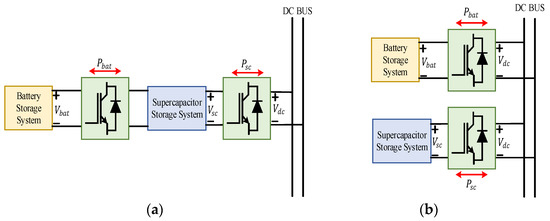
Figure 4.
(a) Cascaded active topology, (b) Parallel active topology.
A parallel active type of connection is shown in Figure 4b. Here, both supercapacitor and battery are isolated from the DC bus by their respective DC/DC converters. This is the most widely accepted connection in microgrid applications. Here, battery tackles the average power requirement due to its high energy density capacity and SC handles the high-frequency power components due to its high-power density capacity [30]. Optimal utilization of HESS is done due to their complementary characteristics. The parallel active connection is implemented in power system applications due to the following advantages.
- Flexibility is improved due to the decoupled control of the battery and supercapacitor;
- Different types of control schemes (both centralized and decentralized) can be implemented;
- The terminal voltage of the battery and SC are independent of the DC bus voltage.
3. Power Management Technologies
The integrated RESs, HESS, loads, and utility grids in a microgrid require a proper control scheme for the reliable operation of the system. For this, a proper power management system (PMS) is required, which ensures the power equilibrium in the microgrid. The power management technique is a two-level control structure. In the first level, it will maintain the DC bus voltage and current flow in the system. In the second level, the proper power allocation to the integrated devices, and SOC regulation of storage systems are mainly focused. The main objectives of the PMS are summarized in Figure 5a. The Coulombic and volumetric efficiencies of HESS should be maximized, while improving the power quality and stability of the system at the DC bus. Protection and lifespan extension of connected equipment. Nowadays, scheduling of loads is included in the PMS to avoid the peak hour rush and to reduce the operating cost.
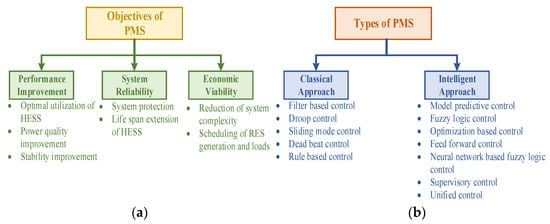
Figure 5.
(a) Objectives of PMS, (b) Types of power management techniques.
The control scheme for PMS can be broadly classified as classical approach and intelligent approach, as presented in Figure 5b. Filter-based control, sliding mode control (SMC), droop control, deadbeat control, rule-based control, etc. come under the classical control approach. Fuzzy logic control (FLC), optimization-based control, supervisory control, neural network-based fuzzy logic control, feed-forward control (FFC), unified control, and model predictive control (MPC) come under the intelligent control approach.
3.1. Classical Approach
3.1.1. Filter-Based Control Technique
In the filter-based PMS control, the average power and transient power are separated by using a low-pass filter [13]. A conventional filter-based control is shown in Figure 6a. Here, the total system current requirement is calculated from the DC bus voltage deviation by using a voltage controller. The voltage controller is basically a PI controller. Then, the total system current is passed through a low pass filter to extract the steady current components. This average component is supplied by the battery and utility grid. The remaining high-frequency component of the system should be supplied by the supercapacitor. By considering the state of charge of the battery, the total average currents are shared between the battery storage system and the grid by using a sharing coefficient .
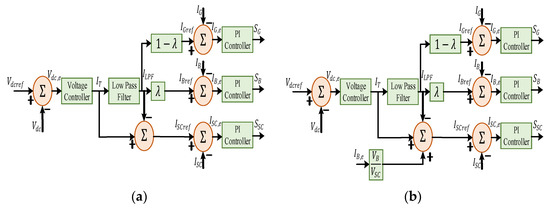
Figure 6.
(a) Conventional filter-based control [13], (b) Modified filter-based control [10].
Because of the slow dynamics of the battery, the battery is not able to track the total reference current . For compensation of uncompensated battery current, a modified filter-based control technique was implemented in [10,30,43], as shown in Figure 6b. The uncompensated battery current is supplied by the supercapacitor units to improve the system’s dynamic performance. The filter-based control technique is very easy to implement, computationally efficient, and gives a faster dynamic response in the system.
3.1.2. Droop Control
For optimal utilization of the HESS, a droop control technique is implemented in [44,45]. In this literature, a combination of virtual resistance droop (VRD) for battery and virtual capacitance droop (VCD) for supercapacitors was considered. The equivalent circuit diagram of HESS with droop control is shown in Figure 7a. The combination of VRD and VCD as shown in Figure 7b can be able to handle both high-frequency and low-frequency current allocation among supercapacitors and batteries. However, this control technique fails to manage the voltage deviation. Hence, a secondary voltage regulation (SVR) is introduced with droop control to control the bus voltage efficiently [46]. The SVR- based droop control for PMS is shown in Figure 7c. Along with bus voltage regulation, this method also recovers the SOCs of HESS irrespective of the leakage current. This SVR with droop control provides a stable dynamic system performance.
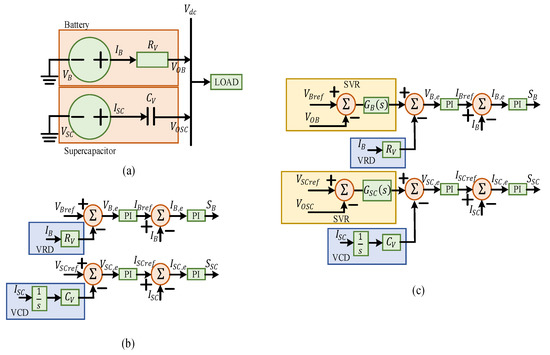
Figure 7.
(a) Equivalent circuit diagram of HESS for droop control, (b) Conventional droop-based PMS, and (c) Droop control with secondary voltage controller-based PMS.
3.1.3. Sliding Mode Control (SMC)
A sliding mode (SM) controller is a type of non-linear controller used in a variable structure system. This SMC can improve the robustness of the system by providing a consistent transient response for a wide operating range [47]. Hence, nowadays implementation of SMC is increased in MG applications for better transient response. A power management technique by using the SMC is proposed in [15,16] for a PV-integrated hybrid AC/DC microgrid with a hybrid storage system. The control structure using a sliding mode controller is shown in Figure 8. Here, mainly variable amplitude PWM carrier signals are generated for the power converters by using the SM controller. This control technique is better to track the output references for HESS and DC bus voltage, and also eliminates the DC current injections to the connected utility grid.
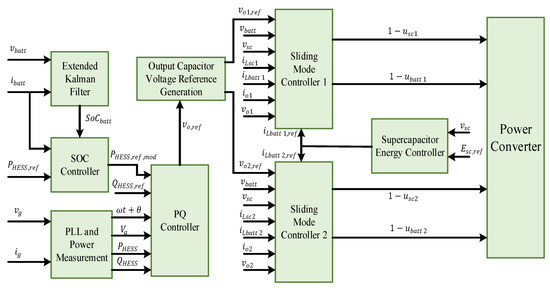
Figure 8.
PMS using sliding mode controller [16].
3.1.4. Rule-Based Control
Generally, in a rule-based control (RBC) technique, a sequence of the decision-making process is carried on by using the present and previous controlled values. The rules are defined either by using the mathematical model of the system or with system expertise. Due to the ease of implementation and less computational burden, rule-based techniques are adopted widely in power management applications. In [48], a rule-based control was proposed to remove the intermittency of renewable energy sources and smooth the power flow in the system. In RBC, the storage devices are turned on or off according to their predefined upper and lower SOC limits, and charging/discharging is done as per the power demand. The rules can be defined by considering the allowable SOC limits of HESS, maximum charging/discharging rates, total generated power, total connected load, etc. This method is one of the easiest methods to implement in real-time applications.
3.1.5. Deadbeat Control
Deadbeat control is designed according to the model of a system so that it can produce an optimal duty ratio in one control cycle. In [49], a deadbeat control-based PMS is proposed for a HESS-based PV integrated DC microgrid as shown in Figure 9. Due to the generation of optimal duty ratio, deadbeat control can respond faster to any disturbances compared to other proportional-integral based control techniques. By considering the characteristics of SC and batteries, with appropriate references, this control method can compensate both transient and steady-state power disparity between generation and demand with an excellent dc bus voltage regulation. Implementation of deadbeat control can reduce the hardware cost by removing the extra current sensors.
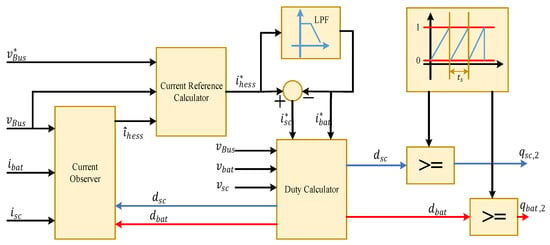
Figure 9.
Deadbeat control-based power management scheme [49].
3.2. Intelligent Approach
3.2.1. Model Predictive Control
Model predictive control is an optimization-based technique that can predict the effect of future control decisions by considering the present system generation. Optimization of the present time frame is possible in MPC while maintaining the future time frame, i.e., it can predict the future in advance and accordingly take the corrective steps. In [50], a model predictive control scheme was implemented for power management in a fuel cell, SC, and a battery-integrated microgrid system. Here, MPC is used to produce the reference current for the power converters, and tracking of references is done by hysteresis control, as shown in Figure 10. Similarly, another efficient power management technique was proposed in [51] with less complicated control by using the MPC. Here, the MPC control helps to limit the current for both battery and supercapacitor and also allocates the high-frequency power requirements to the supercapacitor. This MPC can be implemented in a practical system if the control technique is discretized at a high sampling frequency.
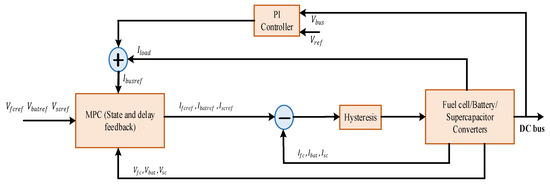
Figure 10.
PMS based on model predictive control [51].
3.2.2. Fuzzy Logic Control (FLC)
A combination of several IF and THEN rules creates the fuzzy logic control, which is basically based on the human experience and knowledge. For any complex system with a number of input variables, system variables, and disturbances, FLC is appropriate to control the system. A basic fuzzy logic-based power management scheme was proposed in [18] for a DC microgrid integrated with hybrid storage system. A FLC-based power management technique was proposed in [19], where varying bus frequency is used for controlling the microgrid system. Here, mainly FLC is employed to avoid overcharging and deep-discharging of the storage devices. Another FLC was proposed in [20] to allocate the reference power to the hybrid storage system. This proposed control technique is shown in Figure 11. Here, FLC will take the power difference between generation and demand, SOC of battery, and SOC of ultracapacitor as inputs, and finally, give the reference battery and ultracapacitor power as system output. This FLC-based technique gives a faster response and is insensitive to any parameter variations.
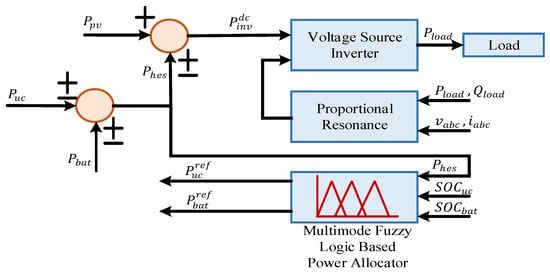
Figure 11.
FLC based control scheme [20].
3.2.3. Optimization-Based Control
For effective framing of rules, some optimization techniques are implemented with previously discussed fuzzy logic control for effective management of microgrids. A bio-inspired algorithm has the capability to handle multi-objective functions and to give optimal solutions in various applications. A particle swarm optimization (PSO) technique was implemented in [52] to optimize the membership functions of FLC for the reduction of the battery peak current. This PSO-based power management structure is shown in Figure 12. The performance of this scheme effectively increases the lifespan of the battery by properly handling the dynamic stress and peak current in the system. In the proposed system, the utilization of supercapacitors has significantly increased compared to other conventional control methods.
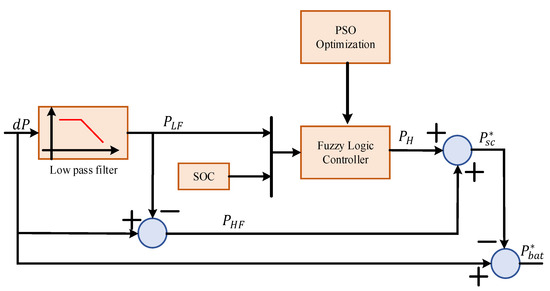
Figure 12.
Optimization-based power management technique [52].
3.2.4. Supervisory Control
A supervisory control for power management is studied in [53] for a hybrid AC/DC microgrid. The authors mainly focused on the integration and co-ordination of the utility grid with the DC microgrid under different operating conditions. The operating conditions are detected by measuring the load currents and powers. Here, the PMS considers the availability of the grid, PV generation variations, changes in the local loads, and the pricing of electric power. The proposed PMS provides effective control under some extreme operating conditions, such as PV off-maximum power point tracking (off-MPPT) operation, load shedding, etc. by eliminating the critical oscillations from the system with the help of hybrid storage devices.
Based on the above discussions for different power management schemes, a comparison is given in Table 4 and Table 5.

Table 4.
Comparison of Different PMS techniques in Classical Approach.

Table 5.
Comparison of Different PMS Techniques in Intelligent Approach.
4. Comparison of Power Management Strategies in AC/DC Microgrids
In the previous sections different classical and intelligent approaches based control techniques are discussed for power management in microgrids. The operation and power management in microgrid should ensure the improvements in power quality, stability, reliability, resiliency, etc. Various combinations of HESS and renewable energy sources are implemented in different microgrids. A number of simulation software, such as MATLAB/Simulink, PSCAD, HOMER, P-graph studio etc., are used and also for hardware implementation dSPACE, DSP, OPAL-RT, STM32F407 microcontroller, etc. are used in the system. Hence, based on the complete analysis of recent techniques utilized for power management in MG applications, a summary is presented in Table 6.

Table 6.
Comparison of Different PM techniques in AC/DC Microgrids.
5. Conclusions
This review article analyzed different control schemes for power management in a microgrid. It focused on the hybridization of different storage devices so that the dynamic power unbalance in the system can be compensated. This paper provides an overview of the characteristics of different storage systems and their interconnection topologies for microgrid applications. Different classical and intelligent approaches to power management are discussed and summarized in Table 4 and Table 5 with their respective advantages and limitations. This paper gives a brief idea about the recent trends in controlling the PV and HESS integrated microgrid in both stand-alone and grid-connected modes. Different extreme operating conditions are also tackled by these control algorithms. This paper will help the researchers to maximize the utilization of renewable sources along with storage devices in the future in both on-grid and off-grid conditions.
Author Contributions
Conceptualization, A.B.; writing—original draft preparation, A.B.; writing—review and editing, P.K.R., B.S. and A.G.; supervision, P.K.R. All authors have read and agreed to the published version of the manuscript.
Funding
This research received no external funding.
Data Availability Statement
Not applicable.
Conflicts of Interest
The authors declare no conflict of interest.
References
- Demirbaş, A. Global Renewable Energy Resources. Energy Sources Part A Recover. Util. Environ. Eff. 2006, 28, 779–792. [Google Scholar] [CrossRef]
- Jing, W.; Lai, C.H.; Wong, W.S.H.H.; Wong, M.L.D. A comprehensive study of battery-supercapacitor hybrid energy storage system for standalone PV power system in rural electrification. Appl. Energy 2018, 224, 340–356. [Google Scholar] [CrossRef]
- Tang, Z.; Lin, Y.; Vosoogh, M.; Parsa, N.; Baziar, A.; Khan, B. Securing Microgrid Optimal Energy Management Using Deep Generative Model. IEEE Access 2021, 9, 63377–63387. [Google Scholar] [CrossRef]
- Yazdanian, M.; Mehrizi-Sani, A. Distributed Control Techniques in Microgrids. IEEE Trans. Smart Grid 2014, 5, 2901–2909. [Google Scholar] [CrossRef]
- Vandoorn, T.L.; Meersman, B.; de Kooning, J.D.M.; Vandevelde, L. Analogy Between Conventional Grid Control and Islanded Microgrid Control Based on a Global DC-Link Voltage Droop. IEEE Trans. Power Deliv. 2012, 27, 1405–1414. [Google Scholar] [CrossRef]
- Hirsch, A.; Parag, Y.; Guerrero, J. Microgrids: A review of technologies, key drivers, and outstanding issues. Renew. Sustain. Energy Rev. 2018, 90, 402–411. [Google Scholar] [CrossRef]
- Hartono, B.S.; Budiyanto, Y.; Setiabudy, R. Review of microgrid technology. In Proceedings of the 2013 International Conference on QiR, Yogyakarta, Indonesia, 25–28 June 2013; pp. 127–132. [Google Scholar]
- Shayeghi, H.; Shahryari, E.; Moradzadeh, M.; Siano, P. A Survey on Microgrid Energy Management Considering Flexible Energy Sources. Energies 2019, 12, 2156. [Google Scholar] [CrossRef]
- Chong, L.W.; Wong, Y.W.; Rajkumar, R.K.; Rajkumar, R.K.; Isa, D. Hybrid energy storage systems and control strategies for stand-alone renewable energy power systems. Renew. Sustain. Energy Rev. 2016, 66, 174–189. [Google Scholar] [CrossRef]
- Bharatee, A.; Ray, P.K.; Ghosh, A. A Power Management Scheme for Grid-connected PV Integrated with Hybrid Energy Storage System. J. Mod. Power Syst. Clean Energy 2022, 10, 954–963. [Google Scholar] [CrossRef]
- Garcia-Torres, F.; Valverde, L.; Bordons, C. Optimal Load Sharing of Hydrogen-Based Microgrids With Hybrid Storage Using Model-Predictive Control. IEEE Trans. Ind. Electron. 2016, 63, 4919–4928. [Google Scholar] [CrossRef]
- Faisal, M.; Hannan, M.A.; Ker, P.J.; Hussain, A.; Mansor, M.B.; Blaabjerg, F. Review of Energy Storage System Technologies in Microgrid Applications: Issues and Challenges. IEEE Access 2018, 6, 35143–35164. [Google Scholar] [CrossRef]
- Tummuru, N.R.; Mishra, M.K.; Srinivas, S. Dynamic Energy Management of Renewable Grid Integrated Hybrid Energy Storage System. IEEE Trans. Ind. Electron. 2015, 62, 7728–7737. [Google Scholar] [CrossRef]
- Singh, P.; Lather, J.S. Variable structure control for dynamic power-sharing and voltage regulation of DC microgrid with a hybrid energy storage system. Int. Trans. Electr. Energy Syst. 2019, 30, e12510. [Google Scholar] [CrossRef]
- Baghaee, H.R.; Mirsalim, M.; Gharehpetian, G.B.; Talebi, H.A. A Decentralized Power Management and Sliding Mode Control Strategy for Hybrid AC/DC Microgrids including Renewable Energy Resources. IEEE Trans. Ind. Inform. 2017. [Google Scholar] [CrossRef]
- Abeywardana, D.B.W.; Hredzak, B.; Agelidis, V.G. A Fixed-Frequency Sliding Mode Controller for a Boost-Inverter-Based Battery-Supercapacitor Hybrid Energy Storage System. IEEE Trans. Power Electron. 2017, 32, 668–680. [Google Scholar] [CrossRef]
- Asensio, E.M.; Magallán, G.A.; de Angelo, C.H.; Serra, F.M. Energy Management on Battery/Ultracapacitor Hybrid Energy Storage System based on Adjustable Bandwidth Filter and Sliding-mode Control. J. Energy Storage 2020, 30, 101569. [Google Scholar] [CrossRef]
- Tejaswini, L.; Ray, P.K.; Bharatee, A. Energy Management of a DC Microgrid for its Voltage and SOC Regulation. In Proceedings of the 2022 International Conference on Intelligent Controller and Computing for Smart Power (ICICCSP), Hyderabad, India, 21–23 July 2022; pp. 1–6. [Google Scholar] [CrossRef]
- al Badwawi, R.; Issa, W.R.; Mallick, T.K.; Abusara, M. Supervisory Control for Power Management of an Islanded AC Microgrid Using a Frequency Signalling-Based Fuzzy Logic Controller. IEEE Trans. Sustain. Energy 2019, 10, 94–104. [Google Scholar] [CrossRef]
- Feng, X.; Gooi, H.B.; Chen, S.X. Hybrid Energy Storage With Multimode Fuzzy Power Allocator for PV Systems. IEEE Trans. Sustain. Energy 2014, 5, 389–397. [Google Scholar] [CrossRef]
- Ray, P.K.; Bharatee, A.; Panda, S.; Satiawan, I.N.W. Modeling and Power Management of Electric Vehicle Charging System. In Proceedings of the 2021 International Conference on Smart-Green Technology in Electrical and Information Systems (ICSGTEIS), Sanur, Bali, Indonesia, 28–30 October 2021; pp. 100–105. [Google Scholar] [CrossRef]
- Fu, Q.; Hamidi, A.; Nasiri, A.; Bhavaraju, V.; Krstic, S.B.; Theisen, P. The Role of Energy Storage in a Microgrid Concept: Examining the opportunities and promise of microgrids. IEEE Electrif. Mag. 2013, 1, 21–29. [Google Scholar] [CrossRef]
- Bocklisch, T. Hybrid energy storage approach for renewable energy applications. J. Energy Storage 2016, 8, 311–319. [Google Scholar] [CrossRef]
- Hamidi, S.A.; Ionel, D.M.; Nasiri, A. Modeling and Management of Batteries and Ultracapacitor for Renewable Energy Support in Electric Power Systems–An Overview. Electr. Power Compon. Syst. 2015, 43, 1434–1452. [Google Scholar] [CrossRef]
- Sharma, R.K.; Mishra, S. Dynamic Power Management and Control of a PV PEM Fuel-Cell-Based Standalone ac/dc Microgrid Using Hybrid Energy Storage. IEEE Trans. Ind. Appl. 2018, 54, 526–538. [Google Scholar] [CrossRef]
- Wang, G.; Ciobotaru, M.; Agelidis, V.G. Power Smoothing of Large Solar PV Plant Using Hybrid Energy Storage. IEEE Trans. Sustain. Energy 2014, 5, 834–842. [Google Scholar] [CrossRef]
- Alnejaili, T.; Drid, S.; Mehdi, D.; Chrifi-Alaoui, L.; Belarbi, R.; Hamdouni, A. Dynamic control and advanced load management of a stand-alone hybrid renewable power system for remote housing. Energy Convers. Manag. 2015, 105, 377–392. [Google Scholar] [CrossRef]
- Spataru, C.; Kok, Y.C.; Barrett, M. Physical energy storage employed worldwide. Energy Procedia 2014, 62, 452–461. [Google Scholar] [CrossRef]
- Sutikno, T.; Arsadiando, W.; Wangsupphaphol, A.; Yudhana, A.; Facta, M. A Review of Recent Advances on Hybrid Energy Storage System for Solar Photovoltaics Power Generation. IEEE Access 2022, 10, 42346–42364. [Google Scholar] [CrossRef]
- Manandhar, U.; Ukil, A.; Gooi, H.B.; Tummuru, N.R.; Kollimalla, S.K.; Wang, B.; Chaudhuri, K. Energy Management and Control for Grid Connected Hybrid Energy Storage System Under Different Operating Modes. IEEE Trans. Smart Grid 2019, 10, 1626–1636. [Google Scholar] [CrossRef]
- Che, L.; Shahidehpour, M. DC Microgrids: Economic Operation and Enhancement of Resilience by Hierarchical Control. IEEE Trans. Smart Grid 2014, 5, 2517–2526. [Google Scholar] [CrossRef]
- Zheng, J.P.; Jow, T.R.; Ding, M.S. Hybrid power sources for pulsed current applications. IEEE Trans. Aerosp. Electron. Syst. 2001, 37, 288–292. [Google Scholar] [CrossRef]
- Lahyani, A.; Venet, P.; Guermazi, A.; Troudi, A. Battery/Supercapacitors Combination in Uninterruptible Power Supply (UPS). IEEE Trans. Power Electron. 2013, 28, 1509–1522. [Google Scholar] [CrossRef]
- Gee, A.M.; Robinson, F.V.P.; Dunn, R.W. Analysis of Battery Lifetime Extension in a Small-Scale Wind-Energy System Using Supercapacitors. IEEE Trans. Energy Convers. 2013, 28, 24–33. [Google Scholar] [CrossRef]
- Cohen, I.J.; Wetz, D.A.; Heinzel, J.M.; Dong, Q. Design and Characterization of an Actively Controlled Hybrid Energy Storage Module for High-Rate Directed Energy Applications. IEEE Trans. Plasma Sci. 2015, 43, 1427–1433. [Google Scholar] [CrossRef]
- Vazquez, S.; Lukic, S.M.; Galvan, E.; Franquelo, L.G.; Carrasco, J.M. Energy Storage Systems for Transport and Grid Applications. IEEE Trans. Ind. Electron. 2010, 57, 3881–3895. [Google Scholar] [CrossRef]
- Pay, S.; Baghzouz, Y. Effectiveness of battery-supercapacitor combination in electric vehicles. In Proceedings of the 2003 IEEE Bologna Power Tech Conference Proceedings, Bologna, Italy, 23–26 June 2003; Volume 3, p. 6. [Google Scholar] [CrossRef]
- Dougal, R.A.; Liu, S.; White, R.E. Power and life extension of battery-ultracapacitor hybrids. IEEE Trans. Compon. Packag. Technol. 2002, 25, 120–131. [Google Scholar] [CrossRef]
- Khaligh, A.; Li, Z. Battery, Ultracapacitor, Fuel Cell, and Hybrid Energy Storage Systems for Electric, Hybrid Electric, Fuel Cell, and Plug-In Hybrid Electric Vehicles: State of the Art. IEEE Trans. Veh. Technol. 2010, 59, 2806–2814. [Google Scholar] [CrossRef]
- Wang, Y.; Wang, W.; Zhao, Y.; Yang, L.; Chen, W. A fuzzy-logic power management strategy based on Markov Random prediction for hybrid energy storage systems. Energies 2016, 9, 25. [Google Scholar] [CrossRef]
- Cao, J.; Emadi, A. A New Battery/UltraCapacitor Hybrid Energy Storage System for Electric, Hybrid, and Plug-In Hybrid Electric Vehicles. IEEE Trans. Power Electron. 2012, 27, 122–132. [Google Scholar] [CrossRef]
- Lukic, S.M.; Wirasingha, S.G.; Rodriguez, F.; Cao, J.; Emadi, A. Power Management of an Ultracapacitor/Battery Hybrid Energy Storage System in an HEV. In Proceedings of the 2006 IEEE Vehicle Power and Propulsion Conference, Windsor, UK, 6–8 September 2006; pp. 1–6. [Google Scholar] [CrossRef]
- Kollimalla, S.K.; Mishra, M.K.; Narasamma, N.L. Design and Analysis of Novel Control Strategy for Battery and Supercapacitor Storage System. IEEE Trans. Sustain. Energy 2014, 5, 1137–1144. [Google Scholar] [CrossRef]
- Xu, Q.; Xiao, J.; Hu, X.; Wang, P.; Lee, M.Y. A Decentralized Power Management Strategy for Hybrid Energy Storage System With Autonomous Bus Voltage Restoration and State-of-Charge Recovery. IEEE Trans. Ind. Electron. 2017, 64, 7098–7108. [Google Scholar] [CrossRef]
- Xu, Q.; Xiao, J.; Wang, P.; Pan, X.; Wen, C. A Decentralized Control Strategy for Autonomous Transient Power Sharing and State-of-Charge Recovery in Hybrid Energy Storage Systems. IEEE Trans. Sustain. Energy 2017, 8, 1443–1452. [Google Scholar] [CrossRef]
- Shi, M.; Chen, X.; Zhou, J.; Chen, Y.; Wen, J.; He, H. Advanced Secondary Voltage Recovery Control for Multiple HESSs in a Droop-Controlled DC Microgrid. IEEE Trans. Smart Grid 2019, 10, 3828–3839. [Google Scholar] [CrossRef]
- Tan, S.-C.; Lai, Y.M.; Tse, C.K. General Design Issues of Sliding-Mode Controllers in DC–DC Converters. IEEE Trans. Ind. Electron. 2008, 55, 1160–1174. [Google Scholar] [CrossRef]
- Teleke, S.; Baran, M.E.; Bhattacharya, S.; Huang, A.Q. Rule-Based Control of Battery Energy Storage for Dispatching Intermittent Renewable Sources. IEEE Trans. Sustain. Energy 2010, 1, 117–124. [Google Scholar] [CrossRef]
- Wang, B.; Manandhar, U.; Zhang, X.; Gooi, H.B.; Ukil, A. Deadbeat Control for Hybrid Energy Storage Systems in DC Microgrids. IEEE Trans. Sustain. Energy 2019, 10, 1867–1877. [Google Scholar] [CrossRef]
- Bambang, R.T.; Rohman, A.S.; Dronkers, C.J.; Ortega, R.; Sasongko, A. Energy Management of Fuel Cell/Battery/Supercapacitor Hybrid Power Sources Using Model Predictive Control. IEEE Trans. Ind. Inform. 2014, 10, 1992–2002. [Google Scholar] [CrossRef]
- Hredzak, B.; Agelidis, V.G.; Demetriades, G.D. A Low Complexity Control System for a Hybrid DC Power Source Based on Ultracapacitor–Lead–Acid Battery Configuration. IEEE Trans. Power Electron. 2014, 29, 2882–2891. [Google Scholar] [CrossRef]
- Chong, L.W.; Wong, Y.W.; Rajkumar, R.K.; Isa, D. An optimal control strategy for standalone PV system with Battery-Supercapacitor Hybrid Energy Storage System. J. Power Sources 2016, 331, 553–565. [Google Scholar] [CrossRef]
- Kotra, S.; Mishra, M.K. A Supervisory Power Management System for a Hybrid Microgrid With HESS. IEEE Trans. Ind. Electron. 2017, 64, 3640–3649. [Google Scholar] [CrossRef]
- Chang, J.-W.; Chae, S.; Lee, G.-S. Distributed Optimal Power Sharing Strategy in an Islanded Hybrid AC/DC Microgrid to Improve Efficiency. IEEE Trans. Power Deliv. 2022. [Google Scholar] [CrossRef]
- Bi, K.; Lu, Y.; Zhuang, Y.; Zhu, Y.; Fan, Q. Decoupling Power Balancing Strategy with Reduced Current Sensors for Two-phase Interleaved Neutral Point Clamped DC/DC Converter Applied in Energy Storage System. IEEE Trans. Energy Convers. 2022. [Google Scholar] [CrossRef]
- Samadhiya, A.; Namrata, K.; Kumar, N. An Experimental Performance Evaluation and Management of a Dual Energy Storage System in a Solar Based Hybrid Microgrid. Arab. J. Sci. Eng. 2022, 1–24. [Google Scholar] [CrossRef]
- Merabet, A.; Al-Durra, A.; El-Saadany, E.F. Improved Feedback Control and Optimal Management for Battery Storage System in Microgrid Operating in Bi-directional Grid Power Transfer. IEEE Trans. Sustain. Energy 2022. [Google Scholar] [CrossRef]
- Alam, M.S.; Al-Ismail, F.S.; Abido, M.A. Power management and state of charge restoration of direct current microgrid with improved voltage-shifting controller. J. Energy Storage 2021, 44, 103253. [Google Scholar] [CrossRef]
- Nabatirad, M.; Razzaghi, R.; Bahrani, B. Decentralized Energy Management and Voltage Regulation in Islanded DC Microgrids. IEEE Syst. J. 2022. [Google Scholar] [CrossRef]
- Nguyen, N.-D.; Yoon, C.; Lee, Y.I. A standalone energy management system of battery/supercapacitor hybrid energy storage system for electric vehicles using model predictive control. IEEE Trans. Ind. Electron. 2022. [Google Scholar] [CrossRef]
- Zhang, M.; Xu, Q.; Zhang, C.; Nordström, L.; Blaabjerg, F. Decentralized Coordination and Stabilization of Hybrid Energy Storage Systems in DC Microgrids. IEEE Trans. Smart Grid 2022, 13, 1751–1761. [Google Scholar] [CrossRef]
- Kaysal, A.; Köroğlu, S.; Oğuz, Y. Hierarchical energy management system with multiple operation modes for hybrid DC microgrid. Int. J. Electr. Power Energy Syst. 2022, 141, 108149. [Google Scholar] [CrossRef]
- Liu, X.; Suo, Y.; Zhang, Z.; Song, X.; Zhou, J. A New Model Predictive Current Control Strategy for Hybrid Energy Storage System Considering the SOC of the Supercapacitor. IEEE J. Emerg. Sel. Top. Power Electron. 2022. [Google Scholar] [CrossRef]
- Panda, M.; Devara, V.B.; Maity, T. A novel dc bus-signaling based power management strategy for dc microgrid. Int. Trans. Electr. Energy Syst. 2021, 31, e12758. [Google Scholar] [CrossRef]
Publisher’s Note: MDPI stays neutral with regard to jurisdictional claims in published maps and institutional affiliations. |
© 2022 by the authors. Licensee MDPI, Basel, Switzerland. This article is an open access article distributed under the terms and conditions of the Creative Commons Attribution (CC BY) license (https://creativecommons.org/licenses/by/4.0/).